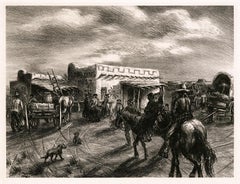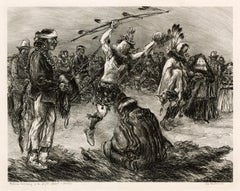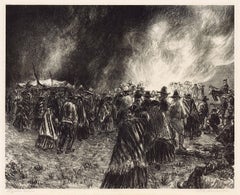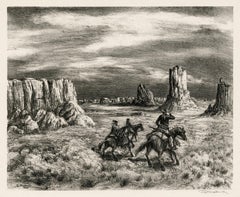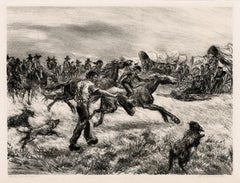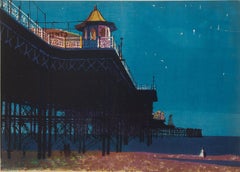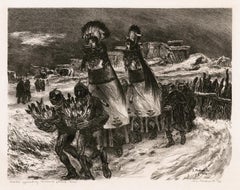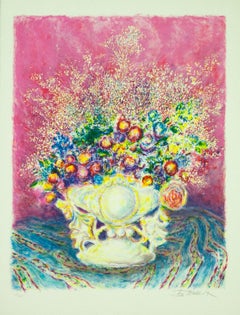Ira Moskowitz Prints and Multiples
to
1
11
8
2
8
2
Overall Height
to
Overall Width
to
5
2
1
8
5
4
3
2
2
1
1
1
1
1
1
1
1
1
1
11
7
11
978
777
658
625
10
1
Artist: Ira Moskowitz
'Navajo Trading Post' — 1940s Southwest Regionalism
By Ira Moskowitz
Located in Myrtle Beach, SC
Ira Moskowitz, 'Navajo Trading Post', lithograph, 1946, edition 30, Czestochowski 161. Signed and dated in the stone, lower left. A fine, richly-inked impression, on cream wove paper, with full margins (1 1/2 to 3 1/8 inches). Pale mat line, otherwise in excellent condition. Matted to museum standards, unframed.
Image size 11 11/16 x 15 1/2 inches (297 x 395 mm); sheet size 16 5/16 x 191/8 inches (414 x 486 mm).
ABOUT THE ARTIST
Ira Moskowitz was born in Galicia, Poland, in 1912, emigrating with his family to New York in 1927. He enrolled at the Art Student's League and studied there from 1928-31. In 1935, Moskowitz traveled to Paris and then lived until 1937 in what is now Israel. He returned to the United States in 1938 to marry artist Anna Barry in New York. The couple soon visited Taos and Santa Fe in New Mexico, returning for extended periods until 1944, when they moved there permanently, staying until 1949. During this especially productive New Mexico period, Moskowitz received a Guggenheim fellowship. His work was inspired by the New Mexico landscape and the state’s three cultures (American Southwest, Native American, and Mexican). He focused on Pueblo and Navajo life, producing an extensive oeuvre of authentic American Indian imagery. He and Anna also visited and sketched across the border in Old Mexico. While in the Southwest, Moskowitz flourished as a printmaker while continuing to produce oils and watercolors. Over 100 of Moskowitz’s works depicting Native American ceremonies were used to illustrate the book American Indian Ceremonial Dances by John Collier, Crown Publishers, New York, 1972.
After leaving the Southwest, printmaking remained an essential medium for the artist while his focus changed to subject matter celebrating Judaic religious life and customs. These works were well received early on, and Moskowitz was content to stay with them the rest of his life. From 1963 until 1966, Moskowitz lived in Paris, returning to New York City in 1967, where he made his permanent home until he died in 2001.
Shortly before his death, Zaplin-Lampert Gallery of Santa Fe staged an exhibition of the artist's works, December 2000 - January 2001. Other one-person shows included the 8th Street Playhouse, New York, 1934; Houston Museum, 1941; and the San Antonio Museum, 1941. The artist’s work was included in exhibitions at the Art Students League, Art Institute of Chicago, Philadelphia Print Club, College Art Association (promotes excellence in scholarship and teaching), and the International Exhibition of Graphic Arts (shown at MOMA, 1955).
Moskowitz’s lithographs of American Indian...
Category
1940s American Modern Ira Moskowitz Prints and Multiples
Materials
Lithograph
'Taos - Relic of the Insurrection of 1845' — 1940s Southwest Regionalism
By Ira Moskowitz
Located in Myrtle Beach, SC
Ira Moskowitz, 'Relic of the Insurrection of 1845' also 'Taos Pueblo with Ruin)', lithograph, 1944, edition 30, Czestochowski 121. Signed and titled in pencil. Signed and dated in the stone, lower right. A fine, richly-inked impression, on cream wove paper, with full margins (1 3/8 to 1 15/16 inches). Very pale light toning within a previous mat opening, otherwise in excellent condition. Matted to museum standards, unframed.
Image size 11 5/8 x 15 1/2 inches (296 x 394 mm); sheet size 15 1/8 x 19 inches (384 x 483 mm).
ABOUT THE IMAGE
The Taos Revolt was a populist insurrection in January 1847 by Hispano and Pueblo allies against the United States occupation of present-day northern New Mexico during the Mexican–American War. The rebels killed provisional governor Charles Bent and several other Americans. In two short campaigns, United States troops and militia crushed the rebellion of the Hispano and Pueblo people. The New Mexicans, seeking better representation, regrouped and fought three more engagements, but after being defeated, they abandoned open warfare. The hatred of New Mexicans for the occupying American army, combined with the rebelliousness of Taos residents against imposed outside authority, were causes of the revolt. In the uprising's aftermath, the Americans executed at least 28 rebels. The Treaty of Guadalupe Hidalgo in 1850 guaranteed the property rights of New Mexico's Hispanic and American Indian residents.
ABOUT THE ARTIST
Ira Moskowitz was born in Galicia, Poland, in 1912, emigrating with his family to New York in 1927. He enrolled at the Art Student's League and studied there from 1928-31. In 1935, Moskowitz traveled to Paris and then lived until 1937 in what is now Israel. He returned to the United States in 1938 to marry artist Anna Barry in New York. The couple soon visited Taos and Santa Fe in New Mexico, returning for extended periods until 1944, when they moved there permanently, staying until 1949. During this especially productive New Mexico period, Moskowitz received a Guggenheim fellowship. His work was inspired by the New Mexico landscape and the state’s three cultures (American Southwest, Native American, and Mexican). He focused on Pueblo and Navajo life, producing an extensive oeuvre of authentic American Indian imagery. He and Anna also visited and sketched across the border in Old Mexico. While in the Southwest, Moskowitz flourished as a printmaker while continuing to produce oils and watercolors. Over 100 of Moskowitz’s works depicting Native American ceremonies were used to illustrate the book American Indian Ceremonial Dances by John Collier, Crown Publishers, New York, 1972.
After leaving the Southwest, printmaking remained an essential medium for the artist while his focus changed to subject matter celebrating Judaic religious life and customs. These works were well received early on, and Moskowitz was content to stay with them the rest of his life. From 1963 until 1966, Moskowitz lived in Paris, returning to New York City in 1967, where he made his permanent home until he died in 2001.
Shortly before his death, Zaplin-Lampert Gallery of Santa Fe staged an exhibition of the artist's works, December 2000 - January 2001. Other one-person shows included the 8th Street Playhouse, New York, 1934; Houston Museum, 1941; and the San Antonio Museum, 1941. The artist’s work was included in exhibitions at the Art Students League, Art Institute of Chicago, Philadelphia Print Club, College Art Association (promotes excellence in scholarship and teaching), and the International Exhibition of Graphic Arts (shown at MOMA, 1955).
Moskowitz’s lithographs of American Indian...
Category
1940s American Modern Ira Moskowitz Prints and Multiples
Materials
Lithograph
'Navajo Medicine Ceremony of the Night Chant' — 1940s Southwest Regionalism
By Ira Moskowitz
Located in Myrtle Beach, SC
Ira Moskowitz, 'The Three Gods of Healing (Navajo Medicine Ceremony of the Night Chant)', lithograph, 1945, edition 30, Czestochowski 148. Signed and titled in pencil. Signed and dated in the stone, lower right. A fine, richly-inked impression, on cream wove paper, with full margins (2 1/4 to 2 3/4 inches), in excellent condition. Matted to museum standards, unframed.
Image size 12 1/4 x 15 13/16 inches (311 x 402 mm); sheet size 17 1/8 x 20 7/8 inches (435 x 530 mm).
ABOUT THIS WORK
The nine-night ceremony known as the Night Chant or Nightway is believed to date from around 1000 B.C.E. when it was first performed by the Indians who lived in Canyon de Chelly (now eastern Arizona). It is considered the most sacred of all Navajo ceremonies and one of the most difficult and demanding to learn, as it encompasses hundreds of songs, dozens of prayers, and several highly complex sand paintings. And yet the demand for Night Chants is so great that as many as fifty such ceremonies might be held during a single winter season, which lasts eighteen to twenty weeks.
The Night Chant is designed both to cure people who are ill and to restore the order and balance of human and non-human relationships within the Navajo universe. Led by a trained medicine man who has served a long apprenticeship and learned the intricate and detailed practices that are essential to the chant, the ceremony itself is capable of scaring off sickness and ugliness through techniques that shock or arouse. Once the disorder has been removed, order and balance are restored through song, prayer, sand painting, and other aspects of the ceremony.
The medicine men who supervise the Night Chant ensure that everything—each dot and line in every sand painting, each verse in every song, each feather on each mask is arranged precisely, or it will not bring about the desired result. There are probably as many active Night Chant medicine men today as at any time in Navajo history due to the general increase in the Navajo population, the popularity of the ceremony, and the central role it plays in Navajo life and health.
ABOUT THE ARTIST
Ira Moskowitz was born in Galicia, Poland, in 1912, emigrating with his family to New York in 1927. He enrolled at the Art Student's League and studied there from 1928-31. In 1935, Moskowitz traveled to Paris and then lived until 1937 in what is now Israel. He returned to the United States in 1938 to marry artist Anna Barry in New York. The couple soon visited Taos and Santa Fe in New Mexico, returning for extended periods until 1944, when they moved there permanently, staying until 1949. During this especially productive New Mexico period, Moskowitz received a Guggenheim fellowship. His work was inspired by the New Mexico landscape and the state’s three cultures (American Southwest, Native American, and Mexican). He focused on Pueblo and Navajo life, producing an extensive oeuvre of authentic American Indian imagery. He and Anna also visited and sketched across the border in Old Mexico. While in the Southwest, Moskowitz flourished as a printmaker while continuing to produce oils and watercolors. Over 100 of Moskowitz’s works depicting Native American ceremonies were used to illustrate the book American Indian Ceremonial Dances by John Collier, Crown Publishers, New York, 1972.
After leaving the Southwest, printmaking remained an essential medium for the artist while his focus changed to subject matter celebrating Judaic religious life and customs. These works were well received early on, and Moskowitz was content to stay with them the rest of his life. From 1963 until 1966, Moskowitz lived in Paris, returning to New York City in 1967, where he made his permanent home until he died in 2001.
Shortly before his death, Zaplin-Lampert Gallery of Santa Fe staged an exhibition of the artist's works, December 2000 - January 2001. Other one-person shows included the 8th Street Playhouse, New York, 1934; Houston Museum, 1941; and the San Antonio Museum, 1941. The artist’s work was included in exhibitions at the Art Students League, Art Institute of Chicago, Philadelphia Print Club, College Art Association (promotes excellence in scholarship and teaching), and the International Exhibition of Graphic Arts (shown at MOMA, 1955).
Moskowitz’s lithographs of...
Category
1940s American Modern Ira Moskowitz Prints and Multiples
Materials
Lithograph
'Navajo Courtship Dance' — 1940s Southwest Regionalism
By Ira Moskowitz
Located in Myrtle Beach, SC
Ira Moskowitz, 'Navajo Courtship Dance (Squaw Dance)', lithograph, 1946, edition 30, Czestochowski 161. Signed and titled in pencil. Signed and dated in the stone, lower left. A fine, richly-inked impression, on cream wove paper; the full sheet with margins (7/16 to 2 3/4 inches). Pale mat line, otherwise in excellent condition. Matted to museum standards, unframed.
Image size 11 13/16 x 14 13/16 inches (300 x 376 mm); sheet size 13 1/16 x 20 1/8 inches (332 x 511 mm).
ABOUT THE ARTIST
Ira Moskowitz was born in Galicia, Poland, in 1912, emigrating with his family to New York in 1927. He enrolled at the Art Student's League and studied there from 1928-31. In 1935, Moskowitz traveled to Paris and then lived until 1937 in what is now Israel. He returned to the United States in 1938 to marry artist Anna Barry in New York. The couple soon visited Taos and Santa Fe in New Mexico, returning for extended periods until 1944, when they moved there permanently, staying until 1949. During this especially productive New Mexico period, Moskowitz received a Guggenheim fellowship. His work was inspired by the New Mexico landscape and the state’s three cultures (American Southwest, Native American, and Mexican). He focused on Pueblo and Navajo life, producing an extensive oeuvre of authentic American Indian imagery. He and Anna also visited and sketched across the border in Old Mexico. While in the Southwest, Moskowitz flourished as a printmaker while continuing to produce oils and watercolors. Over 100 of Moskowitz’s works depicting Native American ceremonies were used to illustrate the book American Indian Ceremonial Dances by John Collier, Crown Publishers, New York, 1972.
After leaving the Southwest, printmaking remained an essential medium for the artist while his focus changed to subject matter celebrating Judaic religious life and customs. These works were well received early on, and Moskowitz was content to stay with them the rest of his life. From 1963 until 1966, Moskowitz lived in Paris, returning to New York City in 1967, where he made his permanent home until he died in 2001.
Shortly before his death, Zaplin-Lampert Gallery of Santa Fe staged an exhibition of the artist's works, December 2000 - January 2001. Other one-person shows included the 8th Street Playhouse, New York, 1934; Houston Museum, 1941; and the San Antonio Museum, 1941. The artist’s work was included in exhibitions at the Art Students League, Art Institute of Chicago, Philadelphia Print Club, College Art Association (promotes excellence in scholarship and teaching), and the International Exhibition of Graphic Arts (shown at MOMA, 1955).
Moskowitz’s lithographs of...
Category
1940s American Modern Ira Moskowitz Prints and Multiples
Materials
Lithograph
'Navajo Reservation Landscape' — 1940s Southwest Regionalism
By Ira Moskowitz
Located in Myrtle Beach, SC
Ira Moskowitz, 'Navajo Reservation Landscape', lithograph, 1945, edition c. 30. Signed and titled in pencil. Signed and dated in the stone, lower left. A fine, richly-inked impression, on cream wove paper, the full sheet with margins (1 3/8 to 2 inches), in excellent condition. Matted to museum standards, unframed.
Image size 12 3/4 x 15 3/4 inches (324 x 400 mm); sheet size: 15 1/2 x 19 inches (394 x 482 mm).
ABOUT THE ARTIST
Ira Moskowitz was born in Galicia, Poland, in 1912, emigrating with his family to New York in 1927. He enrolled at the Art Student's League and studied there from 1928-31. In 1935, Moskowitz traveled to Paris and then lived until 1937 in what is now Israel. He returned to the United States in 1938 to marry artist Anna Barry in New York. The couple soon visited Taos and Santa Fe in New Mexico, returning for extended periods until 1944, when they moved there permanently, staying until 1949. During this especially productive New Mexico period, Moskowitz received a Guggenheim fellowship. His work was inspired by the New Mexico landscape and the state’s three cultures (American Southwest, Native American, and Mexican). He focused on Pueblo and Navajo life, producing an extensive oeuvre of authentic American Indian imagery. He and Anna also visited and sketched across the border in Old Mexico. While in the Southwest, Moskowitz flourished as a printmaker while continuing to produce oils and watercolors. Over 100 of Moskowitz’s works depicting Native American ceremonies were used to illustrate the book American Indian Ceremonial Dances by John Collier, Crown Publishers, New York, 1972.
After leaving the Southwest, printmaking remained an essential medium for the artist while his focus changed to subject matter celebrating Judaic religious life and customs. These works were well received early on, and Moskowitz was content to stay with them the rest of his life. From 1963 until 1966, Moskowitz lived in Paris, returning to New York City in 1967, where he made his permanent home until he died in 2001.
Shortly before his death, Zaplin-Lampert Gallery of Santa Fe staged an exhibition of the artist's works, December 2000 - January 2001. Other one-person shows included the 8th Street Playhouse, New York, 1934; Houston Museum, 1941; and the San Antonio Museum, 1941. The artist’s work was included in exhibitions at the Art Students League, Art Institute of Chicago, Philadelphia Print Club, College Art Association (promotes excellence in scholarship and teaching), and the International Exhibition of Graphic Arts (shown at MOMA, 1955).
Moskowitz’s lithographs of American Indian...
Category
1940s Ira Moskowitz Prints and Multiples
Materials
Lithograph
'Navajo Horse Race' — 1940s Southwest Regionalism
By Ira Moskowitz
Located in Myrtle Beach, SC
Ira Moskowitz, 'Navajo Horse Race', lithograph, 1946, edition 30, Czestochowski 204. Signed and titled in pencil. Signed and dated in the stone, lower le...
Category
1940s American Modern Ira Moskowitz Prints and Multiples
Materials
Lithograph
Judaica interior scene etching with hand coloring
By Ira Moskowitz
Located in Surfside, FL
I believe the scene is of a wedding engagement. etching with extensive hand coloring (making it a unique original work of art)
Ira Moskowitz (1912-2001), descendant of a long rabbinical line, was born in Galicia Poland and went with his family to Prague, Czechoslovakia, in 1914. The family remained there until 1927, and young Moskowitz received his first education in Prague's schools. Soon after, his family moved to New York City, and in 1927 Moskowitz became the pupil of Henry Wickey at the Art Students League, having finally resolved his conflict between a passion for drawing and a desire to follow the rabbinical profession of his forefathers. Between 1935 and 1938, he traveled to Israel and to Europe, Paris, France where he studied the works of the old masters, an interest derived from his first teacher and one that eventually led to his active collaboration in 1954 on the four-volume series, "Great Drawings of All Time."
In 1939, Moskowitz made his first trip to Mexico, and stayed for six months. In 1943 he received a Guggenheim Fellowship and moved to New Mexico, where he remained for seven years drawing the Indians and becoming an active member of the Taos-Sante Fe artists group. It was in New York, as a student of Harry Wickey and Jerome Meyers at the Art Students League ( 1928 -32), that Moskowitz honed his talents as an artist. In the mid-to-late 1930s in Mexico, Ira was drawn to the traditions of the native peoples; in Israel, what was then British MandatePalestine he was absorbed with the religious ceremonies of the Hasidic Jews. The prints and drawings Moskowitz created in Mexico in 1941 earned him a Guggenheim Fellowship in 1943.
In 1944, Ira and his wife, the artist Anna Barry moved to Taos, New Mexico. Moskowitz was entranced by New Mexico's light, landscapes, and cultures. By the time Ira arrived there, the region had already attracted Georgia O'Keeffe, Robert Henri, and Leon Gaspard...
Category
20th Century Post-Impressionist Ira Moskowitz Prints and Multiples
Materials
Lithograph
Floral Still Life
By Ira Moskowitz
Located in Mount Vernon, NY
Signed vintage lithograph of a floral still life by Polish-born Ira Moskowitz (1912 - 2001), who emigrated at the age of 15 from Europe to New York where ...
Category
Late 20th Century Ira Moskowitz Prints and Multiples
Materials
Lithograph
Judaica interior scene etching with hand coloring
By Ira Moskowitz
Located in Surfside, FL
Etching with extensive hand coloring (making it a unique original work of art)
Ira Moskowitz (1912-2001), descendant of a long rabbinical line, was born in Galicia Poland and went with his family to Prague, Czechoslovakia, in 1914. The family remained there until 1927, and young Moskowitz received his first education in Prague's schools. Soon after, his family moved to New York City, and in 1927 Moskowitz became the pupil of Henry Wickey at the Art Students League, having finally resolved his conflict between a passion for drawing and a desire to follow the rabbinical profession of his forefathers. Between 1935 and 1938, he traveled to Israel and to Europe, Paris, France where he studied the works of the old masters, an interest derived from his first teacher and one that eventually led to his active collaboration in 1954 on the four-volume series, "Great Drawings of All Time."
In 1939, Moskowitz made his first trip to Mexico, and stayed for six months. In 1943 he received a Guggenheim Fellowship and moved to New Mexico, where he remained for seven years drawing the Indians and becoming an active member of the Taos-Sante Fe artists group. It was in New York, as a student of Harry Wickey and Jerome Meyers at the Art Students League ( 1928 -32), that Moskowitz honed his talents as an artist. In the mid-to-late 1930s in Mexico, Ira was drawn to the traditions of the native peoples; in Israel, what was then British MandatePalestine he was absorbed with the religious ceremonies of the Hasidic Jews. The prints and drawings Moskowitz created in Mexico in 1941 earned him a Guggenheim Fellowship in 1943.
In 1944, Ira and his wife, the artist Anna Barry moved to Taos, New Mexico. Moskowitz was entranced by New Mexico's light, landscapes, and cultures. By the time Ira arrived there, the region had already attracted Georgia O'Keeffe, Robert Henri, and Leon Gaspard...
Category
20th Century Post-Impressionist Ira Moskowitz Prints and Multiples
Materials
Etching
Street Musicians by Ira Moskowitz original lithograph
By Ira Moskowitz
Located in Paonia, CO
Street Musicians by Ira Moskowitz shows four musicians playing various horn instruments including trumpets and trombones. Behind them some childre...
Category
20th Century Expressionist Ira Moskowitz Prints and Multiples
Materials
Lithograph
Mountain Scene
By Ira Moskowitz
Located in New York, NY
Ira Moskowitz (1912-1985), [Mountain Scene], 1943, lithograph, signed in pencil lower right, numbered lower left (27/50) [also signed and dated 1943 in ...
Category
1940s American Realist Ira Moskowitz Prints and Multiples
Materials
Lithograph
Related Items
Palace Pier, Brighton
Located in Llanbrynmair, GB
’Palace Pier’ Brighton
By Bernard Brett
Medium - Lithograph
Edition - Studio proof
Signed - No
Published by - Curwen Press
Size - 615mm x 435mm
Date - C1975
Condition - Reasonable. 8 out of 10. Some small repaired tears to edge. Not affecting image.
Colour of print may not be accurate when viewed on a monitor.
Bernard Brett, a painter and lithographer, was born in Birmingham. He received his education at Brighton College of Art and later taught at Wolverhampton College of Art from 1951 to 1957. He held the position of Vice Principal at East Surrey College of Art from 1967 to 1975. Brett's artistic contributions included illustrating works published by Curwen Press, and he exhibited his works multiple times at the Royal Academy (RA). In the late 1970s, he is believed to have emigrated to the United States.
Brett's talent extended beyond painting, as he also excelled as a printmaker. His prints, created primarily during the 1960s and 1970s, were known for their vibrant color schemes. His artistic style shared similarities with renowned British artists of his time, including Geoffrey Elliott...
Category
Late 20th Century Other Art Style Ira Moskowitz Prints and Multiples
Materials
Lithograph
Bush scene with blue and yellow
Located in Llanbrynmair, GB
’Bush scene with blue and yellow’
By Jamie Boyd
Medium - Lithograph
Edition - AP
Signed - Yes
Size - 630mm x 865mm
Date - c1975
Condition - Excellent. 10 out of 10.
Colour of print...
Category
1970s Contemporary Ira Moskowitz Prints and Multiples
Materials
Lithograph
Waterfront
By Raphael Soyer
Located in Raleigh, NC
Excellent condition and matted with archival materials.
An excellent addition to any New York or WPA collection.
Category
1930s American Realist Ira Moskowitz Prints and Multiples
Materials
Lithograph
Original "The Ships Are Coming" vintage American poster with an Eagle.
By James Henry Daugherty
Located in Spokane, WA
Original: THE SHIPS ARE COMING vintage poster. Artist: James H. Daugherty (1889-1974)
Publisher: U.S. Shipping Board, Emergency Fleet Corporation, Publication Section, Philadelphia, 1917.
Poster showing a giant eagle...
Category
1910s American Modern Ira Moskowitz Prints and Multiples
Materials
Lithograph
James Henry DaughertyOriginal "The Ships Are Coming" vintage American poster with an Eagle., 1917-18
H 30 in W 20 in D 0.05 in
Glowing City
By Richard Florsheim
Located in New York, NY
Richard Florsheim created this color lithograph entitled “Glowing City” in 1969 in an edition of 250 pieces. Published by Associated American Artists and printed by Mourlot Press, Pa...
Category
1960s American Modern Ira Moskowitz Prints and Multiples
Materials
Lithograph
Original 'Gone with the Wind" vintage German movie poster
Located in Spokane, WA
Original Gone with the Wind “Vom Winde Verweht” vintage lithograph poster.
Original vintage movie poster with professional acid-free linen backing; excellent condition; ready to frame. This is the German 1962 release of Gone with the Wind, printed in the full lithographic style of the old French posters. Unique imagery of the famous scene of the burning of Atlanta.
Starring Clark Gable, Vivien Leigh, Leslie Howard, Olivia de Havilland...
Category
1860s American Modern Ira Moskowitz Prints and Multiples
Materials
Lithograph
Original "Fly to South America" Pan American - Panagra vintage travel poster
By Jean Carlu
Located in Spokane, WA
Original Fly to South America Pan American – Panagra vintage travel poster. Linen backed in excellent condition. Artists were both Jean Carlu and Fred Dubois. 1952 full lithogr...
Category
1950s American Modern Ira Moskowitz Prints and Multiples
Materials
Lithograph
H 42 in W 28 in D 0.05 in
Flowers
Located in Llanbrynmair, GB
’Flowers’
By Jamie Boyd
Medium - Lithograph
Edition - AP
Signed - Yes
Size - 635mm x 870mm
Date - c1975
Condition - Very good. 9 out of 10.
Colour of print may not be accurate when...
Category
1970s Contemporary Ira Moskowitz Prints and Multiples
Materials
Lithograph
Tall Trees
Located in Llanbrynmair, GB
’Tall trees’
By Jamie Boyd
Medium - Lithograph
Edition - AP
Signed - Yes
Size - 635mm x 870mm
Date - c1975
Condition - Good. 9 out of 10.
Colour of print may not be accurate when v...
Category
1970s Contemporary Ira Moskowitz Prints and Multiples
Materials
Lithograph
Jerusalem Marcel Mouly
By Marcel Mouly
Located in Berlin, MD
Marcel Mouly (French 1918 - 2008) “Jerusalem” lithograph on woven paper with deep saturated colors in excellent condition. Well framed with acr...
Category
Mid-20th Century Abstract Ira Moskowitz Prints and Multiples
Materials
Lithograph
Nebraska Evening
By Thomas Hart Benton
Located in London, GB
A fine impression with good margins published by Associated American Artists.
Category
1940s American Modern Ira Moskowitz Prints and Multiples
Materials
Lithograph
Edgartown Yacht Club
By Francis Chapin
Located in Chicago, IL
A striking view of the Edgartown Yacht Club on Martha's Vineyard by Francis Chapin, from around 1958.
Francis Chapin, affectionately called the “Dean of Chicago Painters” by his col...
Category
1950s American Modern Ira Moskowitz Prints and Multiples
Materials
Color, Lithograph
Previously Available Items
'Shalakos Approaching Ceremonial Ground - Zuni' — 1940s Southwest Regionalism
By Ira Moskowitz
Located in Myrtle Beach, SC
Ira Moskowitz, 'Shalakos Approaching Ceremonial Ground - Zuni', lithograph, 1946, edition c. 30, Czestochowski 181. Signed, dated, and titled in pencil. Signed and dated in the stone, lower right. A fine, richly-inked impression, on cream wove paper, with full margins (2 3/16 to 3 13/16 inches), in excellent condition. Matted to museum standards, unframed.
Image size 11 1/2 x 15 1/16 inches (293 x 383 mm); sheet size 17 5/8 x 20 7/8 inches (448 x 530 mm).
ABOUT THIS WORK
The Shálako festival is a succession of traditional dances, chants, and ceremonies conducted by the Native American Zuni people, which takes place each year on or about December 1st. The Shalakos (two men selected by each kiva) perform the sacred ceremony for the dual purpose of invoking the divine blessing upon newly built houses and of rendering thanks to the gods for the year's harvests.
ABOUT THE ARTIST
Ira Moskowitz was born in Galicia, Poland, in 1912, emigrating with his family to New York in 1927. He enrolled at the Art Student's League and studied there from 1928-31. In 1935, Moskowitz traveled to Paris and then lived until 1937 in what is now Israel. He returned to the United States in 1938 to marry artist Anna Barry in New York. The couple soon visited Taos and Santa Fe in New Mexico, returning for extended periods until 1944, when they moved there permanently, staying until 1949. During this especially productive New Mexico period, Moskowitz received a Guggenheim fellowship. His work was inspired by the New Mexico landscape and the state’s three cultures (American Southwest, Native American, and Mexican). He focused on Pueblo and Navajo life, producing an extensive oeuvre of authentic American Indian imagery. He and Anna also visited and sketched across the border in Old Mexico. While in the Southwest, Moskowitz flourished as a printmaker while continuing to produce oils and watercolors. Over 100 of Moskowitz’s works depicting Native American ceremonies were used to illustrate the book American Indian Ceremonial Dances by John Collier, Crown Publishers, New York, 1972.
After leaving the Southwest, printmaking remained an essential medium for the artist while his focus changed to subject matter celebrating Judaic religious life and customs. These works were well received early on, and Moskowitz was content to stay with them the rest of his life. From 1963 until 1966, Moskowitz lived in Paris, returning to New York City in 1967, where he made his permanent home until he died in 2001.
Shortly before his death, Zaplin-Lampert Gallery of Santa Fe staged an exhibition of the artist's works, December 2000 - January 2001. Other one-person shows included the 8th Street Playhouse, New York, 1934; Houston Museum, 1941; and the San Antonio Museum, 1941. The artist’s work was included in exhibitions at the Art Students League, Art Institute of Chicago, Philadelphia Print Club, College Art Association (promotes excellence in scholarship and teaching), and the International Exhibition of Graphic Arts (shown at MOMA, 1955).
Moskowitz’s lithographs of American Indian...
Category
1940s American Modern Ira Moskowitz Prints and Multiples
Materials
Lithograph
Flowers by Ira Moskowitz original limited edition lithograph
By Ira Moskowitz
Located in Paonia, CO
A vibrant colorful flower arrangement in an ornate vase this original limited edition (139/250 ) lithograph by Ira Moskowitz is in excellent condition.
Polish/American arti...
Category
20th Century Expressionist Ira Moskowitz Prints and Multiples
Materials
Lithograph
Jerusalem
By Ira Moskowitz
Located in San Francisco, CA
This artwork titled "Jerusalem" 1969 is an original color etching on wove paper by Polish/American artist Ira Moskowitz, 1912-2001 It is hand signed, dated and numbered XIII/L in pen...
Category
Mid-20th Century American Impressionist Ira Moskowitz Prints and Multiples
Materials
Etching
Wedding Bouquet by Ira Moskowitz
By Ira Moskowitz
Located in Paonia, CO
Wedding Bouquet by Ira Moskowitz is bursting with colors of reds, greens, blue, yellows and white. A larger than life vase overflowing with flowers fills most of the image surf...
Category
20th Century Abstract Impressionist Ira Moskowitz Prints and Multiples
Materials
Lithograph
The Burning Bush
By Ira Moskowitz
Located in Saint Augustine, FL
An original signed lithograph on Arches heavy rag paper by Polish-American artist Ira Moskowitz (1912-2001) titled "The Burning Bush", c. 1972. Hand penci...
Category
1970s Modern Ira Moskowitz Prints and Multiples
Materials
Lithograph
Judaica Etching Chassidic Wedding Chuppah, Hand Watercolor
By Ira Moskowitz
Located in Surfside, FL
Hand colored etching, wedding scene, Judaica. Ed. 63/100
Ira Moskowitz, 1912-1985
Ira Moskowitz was born in Galicia, Poland in 1912, emigrating with his family to New York in 1927 ...
Category
20th Century Modern Ira Moskowitz Prints and Multiples
Materials
Paper, Etching
Judaica interior scene etching with hand coloring
By Ira Moskowitz
Located in Surfside, FL
Etching with extensive hand coloring (making it a unique original work of art)
Ira Moskowitz (1912-2001), descendant of a long rabbinical line, was born in Galicia Poland and went with his family to Prague, Czechoslovakia, in 1914. The family remained there until 1927, and young Moskowitz received his first education in Prague's schools. Soon after, his family moved to New York City, and in 1927 Moskowitz became the pupil of Henry Wickey at the Art Students League, having finally resolved his conflict between a passion for drawing and a desire to follow the rabbinical profession of his forefathers. Between 1935 and 1938, he traveled to Israel and to Europe, Paris, France where he studied the works of the old masters, an interest derived from his first teacher and one that eventually led to his active collaboration in 1954 on the four-volume series, "Great Drawings of All Time."
In 1939, Moskowitz made his first trip to Mexico, and stayed for six months. In 1943 he received a Guggenheim Fellowship and moved to New Mexico, where he remained for seven years drawing the Indians and becoming an active member of the Taos-Sante Fe artists group. It was in New York, as a student of Harry Wickey and Jerome Meyers at the Art Students League ( 1928 -32), that Moskowitz honed his talents as an artist. In the mid-to-late 1930s in Mexico, Ira was drawn to the traditions of the native peoples; in Israel, what was then British MandatePalestine he was absorbed with the religious ceremonies of the Hasidic Jews. The prints and drawings Moskowitz created in Mexico in 1941 earned him a Guggenheim Fellowship in 1943.
In 1944, Ira and his wife, the artist Anna Barry moved to Taos, New Mexico. Moskowitz was entranced by New Mexico's light, landscapes, and cultures. By the time Ira arrived there, the region had already attracted Georgia O'Keeffe, Robert Henri, and Leon Gaspard...
Category
20th Century Post-Impressionist Ira Moskowitz Prints and Multiples
Ira Moskowitz prints and multiples for sale on 1stDibs.
Find a wide variety of authentic Ira Moskowitz prints and multiples available for sale on 1stDibs. You can also browse by medium to find art by Ira Moskowitz in lithograph, etching and more. Much of the original work by this artist or collective was created during the 20th century and is mostly associated with the modern style. Not every interior allows for large Ira Moskowitz prints and multiples, so small editions measuring 15 inches across are available. Customers who are interested in this artist might also find the work of Louis Conrad Rosenberg, Virgil Trasher, and Samuel Chamberlain. Ira Moskowitz prints and multiples prices can differ depending upon medium, time period and other attributes. On 1stDibs, the price for these items starts at $300 and tops out at $1,250, while the average work can sell for $750.
